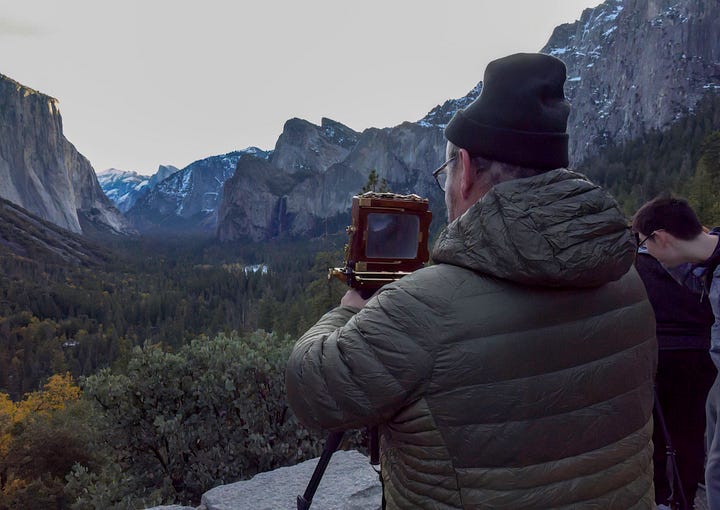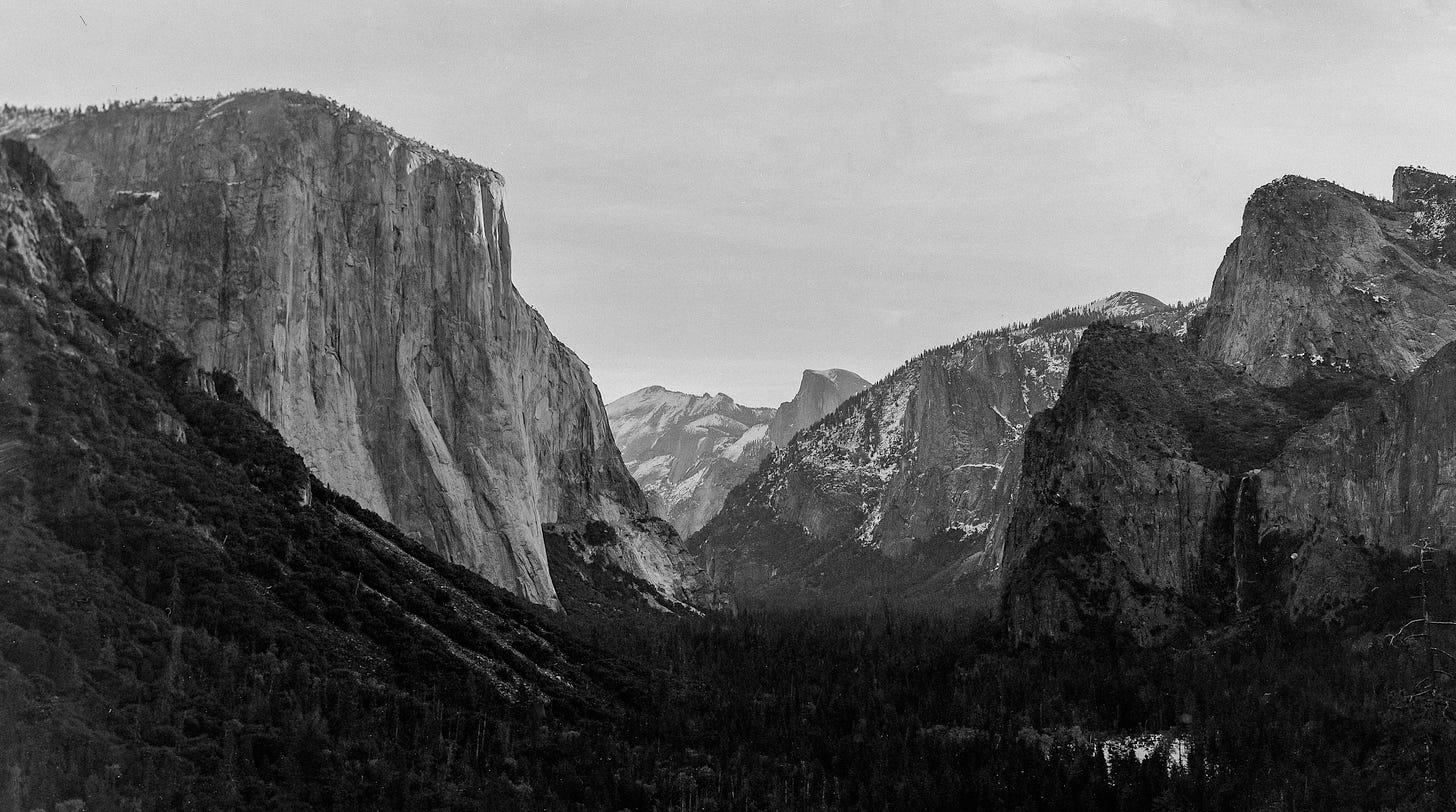Hello All, it’s been a minute since my last post. All I can say is that life is complicated for all of us…
I would like to show you Ansel Adams’ iconic photograph, Clearing Winter Storm, but I believe in respecting copyright laws, so please right-click on the link and open it in a new window. Take a few moments to look at the photo, and try to avoid the temptation to merely glance at it, as most of us do with online images. (Even the Mona Lisa hanging the Louvre only gets an average of 15 seconds of our attention!) This photograph was made by Adams with an 8x10 view camera around 1937 (Adams gave conflicting dates for the original photo).
Over the Thanksgiving weekend, we visited the Ansel Adams Gallery in Yosemite Valley, where I was able to view a framed 16x20 print of this photograph made by Adams in 1972 from the original 1937 negative, available for purchase for $160,000. The price was notable to be sure (another larger version is available if you’re interested) but what I want to reflect on here was the experience of viewing this print from the original negative, as it was unexpectedly moving.
As it was the day before Thanksgiving, the gallery wasn’t very busy, and I was able to just be present with the photograph without any sense that I was inconveniencing anyone else. I just stood there, a foot away from the beautifully presented photograph, and studied the interplay of light and shadow and the variations of form and texture. Simply stunning. I was surprised to find my heart racing, and there was a sense of being in the presence of something truly special. There were several other original prints in the gallery, all beautiful in their own way, but CWS was the only photo in the gallery that elicited a visceral response. This has almost never happened with any image viewed on a computer screen (other than some shocking image of violence), which is yet another reminder that I need to print more of my images, if only for myself.
After our visit to the gallery, we drove to the town of Mariposa, about an hour outside of the valley, where the extended family was gathering for Thanksgiving. Very early on the day after Thanksgiving, a small group of us drove into the valley before sunrise. Even before visiting the gallery, I had planned on photographing some of the same scenes Adams immortalized, which is why I had brought along the 4x5 camera. I’m certainly not the first photographer to do this-there are even tour guides that will take you to the “exact spot” where Adams supposedly stood when he made his most famous photos. After having closely studied CWS in the gallery, I read as much as I could about the history of the making of CWS, and studied the map to find the best accessible location, which is aptly called Tunnel View, since when you exit the tunnel on Wawona road you are rewarded with the spectacular views seen in CWS and in countless photos by untold numbers of photographers over the generations. I was stoked to find out what might await us in the valley.
What awaited us at the Tunnel View parking lot were about 30 photographers, most with tripods mounted with the latest DSLR and mirrorless cameras, and of course many others with smartphones. Somehow I had thought that we would have the place mostly to ourselves, which in retrospect was wishful thinking. I’m not 100% certain, but I believe that I was the only one setting up a 4x5 film camera, which led to the camera and me becoming the subject of several photos…


Looking at all the photographers gathered, and all of the cameras pointing to the same iconic view I was hoping to photograph, I began to have the discomforting realization that I was engaged in “trophy hunting”. I have admired Ansel Adams and his work for so long and have aspired to make images like his, images that might even elicit a visceral reaction in a viewer just like CWS had with me. Of course, I had completely ignored the fact that there was no way that I was going to achieve that on this or any other day, simply because I’m not Ansel Adams. I need to clarify my own vision and make my own images, which might in some small way acknowledge the masters who have come before-but they must be distinctly my images.
After pausing for a few minutes to take in the scene of the photographers and the valley, I understood that there would be no trophy photographs for me today, which was actually helpful and let me relax a bit. I cannot say anything about the other photographers, their motivations, or what they were able to photograph. I continued to set up the 4x5, which isn’t a quick process. I have only been using this camera for a few months (on loan from a fellow photographer in Half Moon Bay) and I have yet to master the finer adjustments that are possible with this type of camera, but the basics are straightforward since the only exposure controls you have are the shutter speed and aperture. There’s no light meter in the camera, so I typically use an App on my iPhone called myLightMeter that does a pretty good job of giving a broad reading. One thing I discovered is that I didn’t compensate enough for the range of luminance from the dark of the forest in the foreground to the light of the sky, meaning I had to do quite a bit of adjustment in Lightroom.
After all the setup it’s actually a bit anticlimactic to make the exposure: it’s just a matter of loading the negative carriers and pushing the plunger on the shutter release cable. So, here we go: (click on the images for a larger version)

The photos I did end up with are seen above. I am happy with what they are, and more importantly, not disappointed with what they're not. Technically, most of the subject elements of Adams’s photo are there, but of course, there’s no comparison. What’s different? The light, the weather, the type of camera-all true. But the glaring differences are two-fold: the vision and the experience.
Over his long career, Adams developed a practice he called “pre-visualization”, which is the practice of mentally visualizing what you wish the final print of the photograph to look like-which might not necessarily be the same as the physical scene that you are actually looking at. Adams explained, “Visualization is a conscious process of projecting the final photographic image in the mind before taking the first steps in actually photographing the subject. Not only do we relate to the subject itself, but we become aware of its potential as an expressive image.” I take this to mean that the first step in making a memorable photograph is to be personally moved by the subject-to connect with it in a way that motivates you to such a degree that you want to share the experience you are having with other people through your photograph-much like the way viewing a sunset or enjoying a wonderful meal is a much deeper experience when it is shared with others. I do not believe that I accomplished this with the above photos because I did not take the time to actually experience what I was looking at, as I was so wrapped up in getting the technicalities right.
To me, by far the best reason to share our photos on social media-isn’t about self-promotion so others will know what a “great photographer” we are, or to brag about being at some exotic location- but because the experience of deeply seeing the subject moved us so much that we just need to share it with others.
This may sound naive, but I hope that at least some of the time, I am able to be clear with myself about the motivations of why I wish to photograph something-and there could be multiple motivations-one of which is because I want the viewer to have a positive experience too. The highest compliment that I could possibly receive would be if somebody told me that one of my photos sparked their curiosity, which moved them to study or appreciate the subject, and finally, they were inspired to use their imagination to conjure up their own potential creative act-as Adams’ photos have inspired me. I firmly believe that curiosity, appreciation, and imagination are the basic building blocks of all deep learning, creativity, and vibrant human communities. So, pick up a camera, a paintbrush or your notebook, or even your favorite cookbook, and share your experience and gifts with others!






I'm so drawn to the light in your color photo -- beautiful. Thank you so much for sharing both your photos and your reflections on this process!